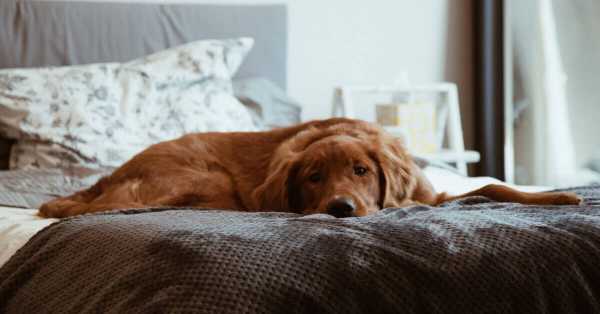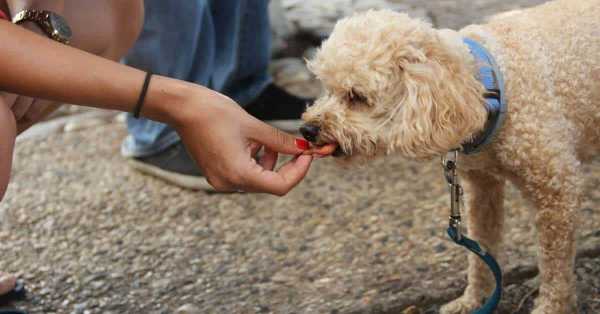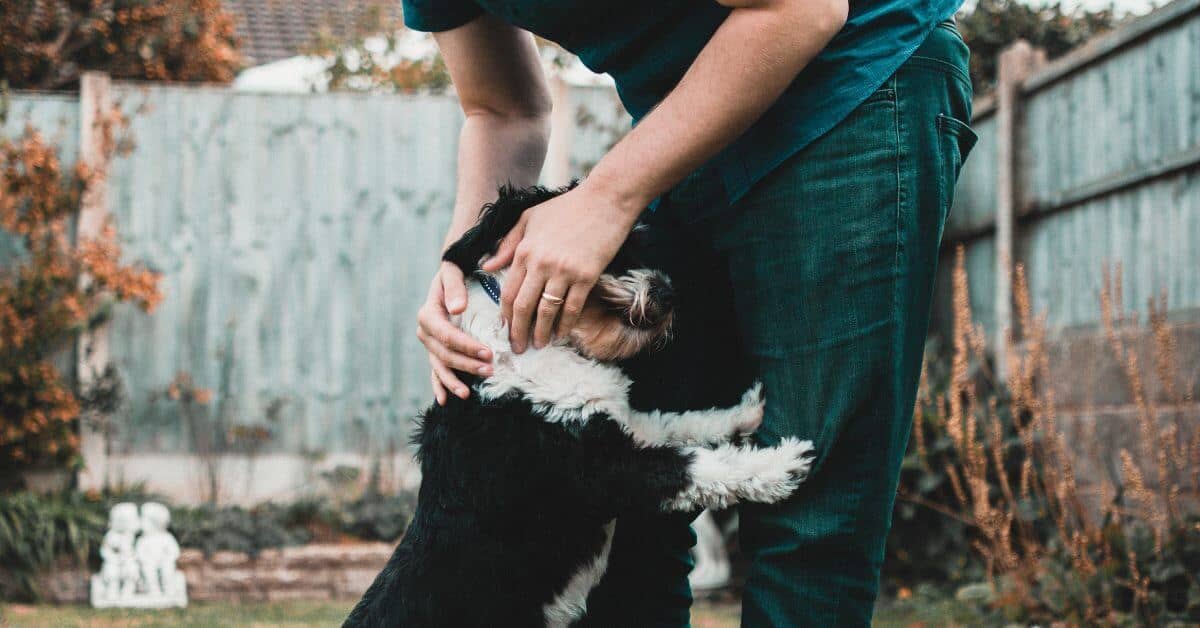My favorite sound to hear is a puppy’s first bark! It usually involves the puppy surprising itself with not knowing what that noise was.
Even though your puppy will start barking more often. It is important to make sure it is not barking when it should not be.
I hope I can share with you some helpful ways to train your new puppy not to bark!

Can You Really Train a Dog to Stop Barking?
Yes! With some hard work, you can actually train your dog to stop barking.
The first thing to do is figure out how many “barks” you are comfortable allowing your dog a day; I think 3 barks is a good place to start.
One of the main reasons why a puppy will bark often is because it is boring and wants attention.
Provide your puppy with lots of toys and bones, and always let your puppy know you are there by petting and playing with him or her.
Things to Avoid When Training A Dog To Stop Barking
Never yell or hit your dog when they are excessively barking, as this will cause them to become frustrated or upset. You want to establish a good relationship with your dog!
Trust me, I know from experience that training a dog to stop barking takes patient and lots of practice.
Why Do Dogs Bark?
A dog barking can be a friendly or threatening response. Most dogs bark to ask you to play with them, to get your attention, or simply because they find it “fun”.
Sometimes, a dog will bark if there is a threat of danger or an intruder, and this is a warning to you the owner as well.
A dog that is barking and snarling with teeth showing is a dog that is angry, so always give space during this type of situation.
How Can I Tell What My Dog Wants When Barking?
This is easy! Take a look at the situation.
Does your dog seem bored?
Hungry?
Thirsty?
or Playful?
Dogs are smart animals. They usually try to communicate with others through barking or whining.
7 Reasons: Why Dogs Bark
Again, dogs bark to communicate! There are many reasons why your dog may be barking. It is important to note that some breeds of dogs bark more than others!
My best friend’s Chihuahua is a daily barker, and my other friend’s Great Dane barks only once a week!
Reason 1: Territorial Barking
Territorial barking occurs when your dog notices an intruder or other animal entering their property. A territorial bark is simply to warn the intruder that the dog sees them and is protecting his or her space.
It is natural for a dog to guard their territory, but when it is accompanied by growling or snapping then this is when it can become a problem.
Reason 2: Alarm Barking
Alarm barking can be a tricky situation to try and control. With this type of barking, the dog typically barks at any noise or alarm they hear (i.e. ambulance siren).
A keyword to teach your dog is “quiet”, which you should practice using treats for a reward.
Reason 3: Attention-Seeking Barking
When a dog feels neglected or bored, he or she may engage in excessive barking. This can be loud and quite annoying to deal with on a regular basis.
Therefore, provide your dog with lots of stimulants like toys and a variety of bones, as well as give your dog lots of love and affection.

Reason 4: Greeting Barking
Just like people, dogs want to say hello when a visitor comes to the door! This is not necessarily a bad form of barking, but if it is accompanied by growling or snapping then this is where a big problem could arise.
I think it is fine to let your dog bark once or twice to say hello, and after that, he or she should know that it is time to stop.
Reason 5: Separation Issues/Compulsive Barking
This type of barking is often seen with dogs who have separation anxiety or who are fearful of certain sounds or unfamiliar objects. Other times, like with compulsive barking, the dog barks because it enjoys it.
This may sound strange, but some dogs like to bark or howl.
Read More: How Dog Bed Can Help Your Dog From Separation Anxiety?
Reason 6: Socially Facilitated Barking
This type of barking is common when dogs hear other dogs barking or become overly excited during playtime with other dogs.
As long as the dog is maintaining a friendly disposition while barking, it is not something that should be considered alarming.
Reason 7: Frustration-Induced Barking
When a dog is placed in a frustrating or anxious situation, it can begin to bark excessively.
Dogs who are confined to a small space and isolated bark out of frustration.
How to Tell If Your Dog Is Barking for the Right Reason?
A puppy can be hard to read as you have only known him or her for a short while. As the puppy grows into an adult dog, it will be easier to get to know the signs of healthy or unhealthy bark.
If your dog is barking to warn you of an intruder or to say hello when the doorbell rings, then this is considered a good reason.
When your dog is excessively barking and growling at a visitor, then this is where you want to intervene.

Ideal Situations for Barking and Not Barking
Your dog should know not to bark when left alone or eating treats.
However, your dog should know that it can bark to greet someone or another furry friend, or when there is an intruder on its property.
What If My Dog Doesn’t Bark?
Don’t panic! Did you know that some dog breeds don’t bark or bark very little?
If your dog is trying to bark and there is no sound then this is when you want to take him or her to the vet. Otherwise, don’t worry and enjoy the peacefulness of no barking!
Why Teach a Dog to Bark?
Teaching your dog to bark or speak is a valuable thing. It gives you control over when and where your dog barks and creates a healthy relationship between owner and dog.
Your dog should be taught to bark when someone knocks at the door or when an unfamiliar face approaches you, as this is a good safety measure.
Teaching When to Bark or Speak
Teaching your dog when to bark and speak is an important way to control when he or she barks.
It will allow you to develop a healthy amount of control over your dog so that they do not engage in excessive barking!
I love using the command “speak” when I want my dog to bark
Training Techniques
In order to successfully train your dog when and when not to bark, you must implement some type of training tactic.
Every dog owner has their own preferred method, so it is best to do some research to find out which one you think will work best for you.
Choose Your Command
Choosing the right command that will work for you is the first important step.
The word should be short but to the point, such as “quiet”, “speak”, “stop”, “hush”, or “bark”.
The “No Bark Command”
Did you know the best way to train your dog to be silent on command is to teach them to bark on command?
This is because your dog learns when to speak and when to not speak.
Training your dog (with lots of treats as rewards, of course) to bark on command will teach him or her to not bark unless they hear the keyword.
Recall Command
Teaching your dog to come back to you during their barking fit is an important way to control them.
The recall command can be done in the form of firmly and loudly calling, “Come” or “Leave it”, so they know to stop whatever they are doing and retrieve it back to you.
Read More: Train Your Puppy To Come When Called
“Speak!”
Again, training your dog to “speak” on command is a helpful way to control excessive barking.
By teaching this command, your dog will know when he or she is allowed to bark and when it is time to stop.
“Settle down” or “Quiet”
These two commands are great for getting your dog to immediately stop barking.
When your dog hears “Settle down” or “Quiet”, which should be said firmly and clearly, they should stop barking instantaneously.
Always reward with a treat or pat on the head.
Sit/Stay Command
One of the most common commands, and personally, two of my favorite to use when training a dog not to bark. Teaching your dog to sit and stay is an important step in practicing patience.
Your dog will have to learn how to sit, stay, and be calm instead of turning to bark whenever they please.
This command is valuable to teach your dog and can be used in a variety of situations, as well.
The Mark and Reward Method
When your puppy does something good, such as not barking during a certain situation, you must quickly “mark” the good behavior by using a clicker or snap your fingers to get their attention and then give them a delicious treat as a reward.
This is a great method used in positive reinforcement training, and it is very helpful in preventing barking.
Squirt Bottle Method
A simpler and non-vocal way to stop your dog from barking is by taking a spray bottle full of room-temperature water, and simply spraying your dog whenever they bark excessively or unnecessarily.
Personally, I do not think this method is ideal in the long run because your voice is the most powerful tool in training.
However, it can work if implemented regularly.

Ways To Stop Your Dog From Barking Inside
Barking inside can be loud and disturbing, especially with young children in the home.
Those owners who have to leave their dogs at home during the day for extended periods of time may have to deal with their dog barking due to boredom or loneliness.
Luckily, there are some great ways to help stop inside barking.
Step 1: Avoid Scolding or Physical Punishment
Never yell or hit your dog for barking inside the home.
This can actually cause a lot of distress in your dog and create even more frustration which will lead to more barking.
No matter how mad you get because of your dog’s barking, always use humane intervention methods.

Step 2: Use a Variety of Rewards
Always provide your dog with a variety of training rewards, such as toys, treats, bones, and love.
Dogs love treats and so you should use this to your advantage when training them to not bark inside the home.
Step 3: Obstruct Your Dog’s View
If you notice your dog staring at something that is triggering his or her barking, then you want to remove your dog from that situation.
If your dog is barking at the neighbors through a window, then try blocking that window from your dog’s reach.
Removing the stimulants of barking before it occurs is a great step to prevent barking.
Step 4: Turn On A Radio, TV, or Fan
The outside world has a lot of noises that can trigger barking!
When you go to work or leave the house, try leaving a radio, TV, or fan on for your dog.
This will not only mask any outside noises but also provide some “company” for your dog.

Step 5: Reward Your Dog When They Don’t Bark
This is one of the most important steps in your training!
Give your dog a special treat when they refrain from barking.
It is very important that they get a reward so they know their behavior was proper.
Step 6: Avoid Bark Collars
Bark collars have shown proof that they work, but in the long run, these kinds of collars are not as effective as using commands and rewards.
Furthermore, certain bark collars can be uncomfortable for dogs to wear and may cause stress to build up when wearing one.
Step 7: Gently Closing the Muzzle
A simple way to show your dog that you do not want them to bark is by gently clasping your hands around their muzzle.
Do not squeeze hard or make them yelp, but gently hold it shut and say the desired command, such as “quiet” or “no”.
Step 8: Be Aware of Triggers
A good dog owner will keep his or her eye out for possible barking triggers, and make sure their dog is removed from the situation or is sitting quietly.
This is part of being a responsible dog owner.

Helpful Tips for Curbing Puppy Barking
Puppy barking is cute, but don’t forget that your beloved puppy will soon become an adult and the barking is no longer as cute (or quiet).
It is a good idea to curb puppy barking as soon as possible so your soon-to-be adult dog knows when and when not to bark.
Don’t Bark Back
Barking back at your dog is not a helpful way to curb barking.
In fact, this can cause even more stress and even confusion to occur.
Remove the Audience
Almost every canine loves attention – especially when they bark! If your pooch barks at you, then say “quiet” or whichever command you desire, and when they stop, reward them immediately.
If your Fido keeps barking then leave the room so they are unable to see you anymore.
Most dogs will stop barking when they realize there is no one around to listen.
Limit Puppy Barks
Barking is a healthy response, but excessive barking is not. Give your puppy a limit on how many barks he or she is allowed per day.
You might want to start anywhere between 3-5 barks depending on the breed of your puppy.

Pay Attention to the Circumstances
Depending on the circumstance you and your puppy are in, you may or not want your puppy to practice not barking.
When socializing with other dogs, your puppy will naturally feel the need to bark or when playing with toys. If your puppy is barking for no reason then you will want to intervene.
Do Door Drills
Practicing situations where your puppy struggles with barking is a great idea.
Ring the doorbell, knock at the door, and have a friend open the door and walk in to practice your puppy’s not barking.
Alleviate Boredom
Puppies get bored easily, especially if they are not given attention.
Provide your puppy with lots of toys, treats, pets, and kisses so they are being stimulated.
Block Scary Sounds
Sounds like the vacuum or garbage truck can be triggers for your puppy.
While it is important to expose your puppy to a variety of sights and sounds, it is also a helpful idea to remove your puppy from scary sounds that trigger barking.
Helpful Head Halters
If you have never tried a head halter before, then you should give one a try!
I love using head halters because they not only slow down the dog during walks, but they prevent over-excitement and barking.
They can be purchased for a fairly inexpensive price at your local pet store.
These are especially great for retrievers or shepherds who like to “pull” when walking.
Try Speaking in a New Tone
If you notice your puppy is not responding well to your commands to stop barking, perhaps you want to try a new tone! Dogs respond to tones and changing them up over time is a helpful tactic.
You may even want to incorporate a whistle into your new tone.

Try a Scent to Curb Barks
Did you know that a lemon or citronella scent can actually prevent dog barking?
It is best placed on the dog’s collar and is used on bark collars quite frequently.
Tire Your Dog Out Daily
This is my favorite way to combat barking! Get your dog outside running around and playing with toys.
When your dog is tired it will typically refrain from whining, barking, and wanting attention because it is tuckered out.
Controlling Barking and Anti-Stress Devices
You wish to use a device to control your puppy’s barking then you will be happy to know that there are many products to choose from.
From my experience of owning dogs, there have been times when anti-stress devices work great and other times when do they do not; it all comes down to your dog!
Ultrasonic Anti-Bark Birdhouse
When placed within the distance of your barking dog, this birdhouse will release a high-pitched sound that is undetectable by humans.
The sound that is emitted is supposed to stop a dog from barking. Most birdhouses can detect barking from up to 50 feet away!

Citronella Dog Collar
The Citronella Dog collar is a collar that uses the smell of citronella to control barking to a minimum.
The collar sprays the scent out which is supposed to prevent the dog from barking.
This method is considered a humane alternative to a shock collar.
Calming Collars
These collars help minimize stress and anxiety in your dog by releasing herbal blends that naturally calm your dog.
They are made out of fabric and the scent is absorbed easily.
I like this type of collar because of its natural approach to reducing stress in dogs!
Thunder Shirt
The Thunder Shirt is designed to be worn by your dog to help soothe any fears (i.e. thunder).
It is a comfortable shirt that snuggly hugs your dog and provides comfort.
It is fairly pricey but I know of so many dogs that benefit from this shirt!
Anxiety Jacket
Similar to the Thunder Shirt, the Anxiety Jacket is similar to a vest and is worn by dogs in situations that are anxious for them.
The vest comfortably sits around their body and provides an extra level of comfort, especially when you are not around.
Advice for Dealing with a Barking Dog
A barking dog can be frustrating, but you must remember that it takes patience and lots of practice to train your dog to stop barking.
There are so many methods and products out there that it can at first be a little overwhelming.
Start slow and find what works best for you and your furry friend.
Correct Barking Problems and Always Follow Through
One of the most detrimental things you the owner can do to your dog’s progress is stop following through with correction and rewards.
Your dog will need lots of practice and reinforcement so be sure to provide him or her with it! Remember, calm, slow and steady is a key.

Be Strong and Stake Your Claim
Don’t be afraid to use your body and mind when working with your dog to stop barking.
The more dedicated you are the more your dog will be able to tell.
You would be surprised at how in tune dogs are with their owners, so be confident when you are redirecting your dog’s behavior at all times.
Provide Mental and Physical Stimulation
Your dog needs to be given lots of exercise and mental stimulation every day.
Some individuals have benefited greatly from signing their dog up to an agility class where they can run to their heart’s content! Others take their dog to the dog park for two hours a day! Find what your dog enjoys the most and run with it.
Always provide your dog with an array of toys that are cognitively stimulating and make sure he or she gets exercise!
Each breed will need a different amount of physical activity per day, so find this out before bringing your puppy home.
Be Calm and Don’t Yell
Yes, you read that right! Be calm and never yell at your dog in a mean way. It is fine to raise your voice to get your point across because canines respond to tones.
However, when you begin screaming at the top of your lungs and even hitting your dog that this becomes not okay!
Your dog cannot use words to communicate, so it is important you remain calm and talk slowly but firmly.
Seek Professional Help
If after trying by yourself to help correct your dog’s barking and you have made no progress, you might want to contact a professional for help.
A professional will be able to create a plan for your dog and help you implement it.
They will also be able to provide you with one on one training and even work with your dog by themselves to help correct the unwanted barking.
How Do I Find the Best Professional to Help?
Read lots of reviews online, ask friends and family members, and always meet the professional dog trainer in person before agreeing to any lessons.
Each trainer will have different philosophies and pricing so check these two things first before signing any papers.
I like to meet for coffee with the potential trainer to really get to know them and ask questions.
Final Thoughts
Hopefully, by now you can consider yourself an expert in training your puppy not to bark!
Some dogs will respond fast to training and others will take their time.
It is important for you to be patient and positive with your dog during training. Different breeds of dogs need different styles of approach, and some breeds are a lot more vocal than others!
Always make sure your dog’s basic needs are being met (love, food, shelter) first before starting with any training.
Further Readings:
10 Boredom Busters for Your Dog
How to Stop Attention-Seeking Behavior
Other Puppy Adoption Related Topics:
1. Top 21 Best Waterproof & Weatherproof Outdoor Dog Beds
2. Top 15 Best Dog Beds For A Bernese Mountain
3. Top 28 Best Beds For Dachshunds

